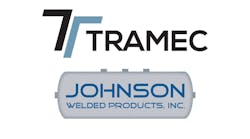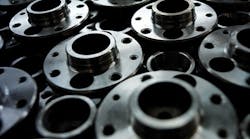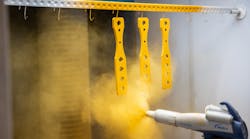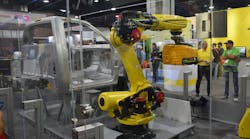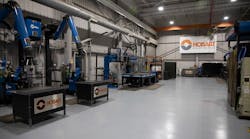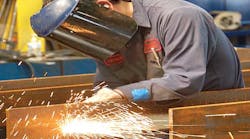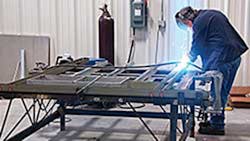MIKE Beels, lean program manager of the Michigan Manufacturing Technology Center, is on a mission to debunk the myth that pervades the job-shop community.
And the myth goes like this: Lean methodologies that apply to high-volume manufacturing companies do not apply to low-volume, high-mix environments such as mom-and-pop shops and one-offs.
“But there are many methodologies you can utilize in any type of organization—it doesn’t even have to be manufacturing,” Beels said. “We’ve been successful in service industries, hospitals, banks.”
In a National Truck Equipment Association (NTEA) webinar, “Practical Lean Methodologies to Streamline Your Shop Process,” Beels presented four lean concepts: 5S and Visual Management; Quick Changeover (QCO)/Single-Minute Exchange of Dies (SMED); Virtual Cell Layout; and Total Productive Maintenance (TPM).
He said 5S and Visual Management is “simply getting clean, safe, and organized. It’s a basic step for any organization to move forward to use any of the other methodologies because it has its hands fully entrenched with these other types of tools we can use going forward.”
5S stands for Sort, Set in Order, Shine, Standardize, and Sustain.
“It is a proven method used to systematically organize, clean, and standardize the workplace that maximizes all phases of the business while minimizing waste,” he said. “Many organizations add safety and security, but we concentrate on these five.”
The 5s benefits:
• Elimination of unneeded equipment. “Now we’re focused on what we actually need. We’re not walking around things we don’t need to get to things we do need.”
• Elimination of excess inventory. “We can help reduce that because it becomes visual.”
• Reduced absenteeism. “We’re now safer. People getting hurt becomes less of a factor because of better lighting and environment. These people want to come to work more.”
• Fewer equipment breakdowns and better availability. “We’re keeping pieces of equipment clean. We can recognize problems much faster.”
• Longer equipment life.
• Tools and information at the point of use.
• Higher quality.
• Efficient and effective navigation and organization; choices are made clear.
• Motion and waste reductions.
• Fewer accidents.
Beels broke down the components of 5S:
• Sort.
“It’s the most difficult for us in Western civilization because once we get our hands on stuff, we typically don’t want to let go of it. But you need to clearly distinguish between what is needed and what is not needed. When in doubt, move it out! Tools and parts are sorted and only the truly essential items can remain. Then remaining items are sorted and stored based on frequency that they are used. Don’t forget the documentation and manuals. There are places we design on the shop floor where we collect items that are not needed, put a red tag on them, and put them in our log, and someone can come forth and obtain them.”
• Set in Order.
“We want to order everything that remains, so we want to have locations visible and self-explanatory. There is no doubt where things go. We use signage or lines on the floor—anything that will show people where things belong. We have designated storage locations. It’s like Ben Franklin’s famous quote: ‘A place for everything and everything in its place.’ This is a culture change. It requires people to get the whole organization understanding the value of this, and then it becomes much easier to find things. We’re not spending time on scavenger hunts, trying to find things we need.”
• Shine.
“Unfortunately, people think all this is about is cleaning. That’s a big part of it. But really, shine incorporates three primary activities: getting the workplace clean; maintaining its appearance; and proving the methods of prevention to keep it clean. It starts with clean floors, but it’s also inspection. We feel that if operators are already cleaning things in the area—their pieces of equipment, hoses, and cables—they can identify things that are wrong, such as cuts, bends in hoses, loose bolts, low oil reservoirs, dirty air filters.”
• Standardize.
“That’s what we do to insure the first three pillars are in place and utilized. We want to provide a checklist for operators so they know what they need to do on a daily, weekly, monthly, yearly basis to keep the 5S program in place. It could include: wipe down saw machine; wipe down machine bench; sweep and mop floor; top off coolant and misters; inventory shadow board; complete process tags; fill out blade charts; and clear table of all personal belongs. It could be on an 8½x11 sheet that tells operators that their responsibilities are on a daily basis.”
• Sustain.
“This is probably the most difficult for us. We’re just not very good at this. We come across some things that are the greatest things since sliced bread, and we don’t sustain them. They become flavor-of-the-month because we don’t follow through. We have to follow through, and the best way is through a company-wide promotion of discipline: 5S audits conducted on a regular basis; 5S photo exhibits (before and after); 5S recognition; 5S schedules, posters, in-house articles and pocket manuals. The more people see it, the more it becomes commonplace. We want it to become the norm, not the exception. There’s a weekly audit check sheet with 15 items, including things like, ‘Are fire extinguishers and exits accessible?’ If not, check no, and then explain what the problem is. It’s important that you put data in places where people will see it—the lunch room or time clock. Peer pressure is an important part of this.”
QCO/SMED
This represents the efforts to reduce the total elapsed time from the last good piece produced of the current run to the first good piece of the next run. If that time can be reduced, the benefits include: lower manufacturing cost; smaller lot sizes; improved responsiveness to customer demand; lower inventory levels; smoother startups; and improved capacity.
“There’s more time available to run your product when we reduce the time that it is down, not making parts,” he said.
Volume too low to implement cellular manufacturing? Consider setting up a virtual cell layout.
Japanese industrial engineer Shigeo Shingo is credited with the development of the Single Minute Exchange of Die (SMED) process over many years. With a bit of revision to his original steps
, Beels suggests the following: eliminate the need for changeover; observe/verify the steps and time in your current changeover process; identify the internal and external steps; convert internal steps to external steps; increase the efficiency of the remaining internal steps; increase the efficiency of external steps; prioritize and implement ideas (90% or more during the improvement event); and update and document standard work, post, train, and audit.
“Standard work is very important to any organization for every single process they do, whether on the shop floor or in the office,” he said. “It’s critical to have one fast way and then make sure everyone does it that way.”
Beels said camcorders or other recording devices are essential tools to be used during a quick changeover event. Videotaping a changeover gives you the option of viewing it as many times as necessary to ensure that you have the correct current state data. The ability to time-stamp the video allows you to break the changeover down into work elements and look for improvements.
He said the use of the set-up analysis chart allows participants to break down the changeover step by step to look for improvement opportunities.
Internal must be separated from external. Internal activity is “all activities that must be performed while the machine is shut down and not producing parts,” while external activity is what “can be performed while the machine is running and producing parts, before or after shutdown.”
“Ask yourself, ‘Does the machine have to be down in order to do this activity?’ ” he said. “Make a checklist and include these items: get dies and tools; remove old dies; center and dimension; retrieve fastener from crib; install new dies; put away tools; complete paperwork; adjustments; store old dies.”
He said using two or more people versus one person to complete a changeover can greatly reduce the changeover time.
“I just recently worked with a company that needed five people to do a changeover,” he said. “You need to identify who needs to do what. If you have a pit-crew mentality to doing a changeover, identify who is doing what. There are obviously a lot of steps that take place for a changeover. We’ve identified who needs to do it, and in the setup analysis, you identify how long it takes so you can balance the work and insure everybody’s doing the same amount, and you get it done as quickly as possible.”
Virtual cell layouts
Although job shops don’t typically have the volume to create dedicated cells to product or product families, the use of a virtual cell can be used to reduce transportation and motion waste
Consider for instance the following scenario:
In one shop, all parts are blanked, most are bent, most are welded and finished, and some parts are powder-coated and assembled. In this case, a virtual cell may be set up between the three principle operations: cutting, bending, and welding and grinding.
A line of turret punches may sit adjacent to raw material. Near the off-load tables sit a row of press brakes, and behind them a row of welding booths. Parts may flow through different lines based on schedule and part design. One part may flow through turret A, press brake B, and weld booth C, while another part may flow through turret B, press brake C and weld booth A. The exact path may vary, but the distance components travel between operations is minimized.
“Although the virtual cell does not minimize handling as much as a lean cell that optimizes one-piece flow, it does help reduce the wastes of motion and transportation since parts need not travel to operations located throughout the facility,” he said.
Total Productive Maintenance (TPM)
Regardless of the size of an organization or whether it is high-volume or high-mix, equipment wellness is critical.
“From one perspective, you could say that TPM is really about creating capacity,” he said. “We want you to have machines running when you want them to run and not breaking down. We’re talking about total company-wide, team-based effort, not just maintenance department.”
Two of the important components of TPM are Overall Equipment Effectiveness (OEE) and Autonomous Maintenance (AM).
Shadow boards are an easy way to keep track of tools.
He said OEE is a measurement tool to allow you to trend the performance of a specific process/machine over a period of time. It measures the impact made during kaizen or autonomous improvements. It’s not meant to be used to compare different processes, machines, departments, or plants.
It’s a measure of equipment performance relative to design performance for the net available time the machine is scheduled to run. It’s calculated using three factors:
• Availability. “The ratio of the amount of time the machine actually runs versus the amount of time it’s scheduled to run.”
• Performance efficiency. “The ratio of the amount of time it should have taken to make a given amount of parts versus the amount of time it actually took.”
• Yield. “The ratio of acceptable parts versus total parts produced.”
These percentages are multiplied together to get the OEE percentage.
The bottom-line cost impact of OEE: If your company improves OEE 10%, you could go from 17,150 pieces to 18,865. At $12 per piece, that’s $20,580. Multiply that by 50 weeks and that’s $1,029,000 per year.
With Autonomous Maintenance, the goal is to develop operators so they can recognize abnormalities and correct minor problems. This is done by performing: daily checks; lubrication; replacement of parts; repairs; and precision checks. It requires training in: function of equipment; proper inspection; cleaning methods; and basic maintenance techniques.
Operator involvement begins with the seven steps of AM: initial cleaning and inspection; eliminating sources of contamination and poor access points; developing tightening, cleaning, lubrication, and inspection standards; general inspection training; perform equipment inspections; work area and process control (develop standard work through visual management documents); and full implementation and continuing improvement. ♦
